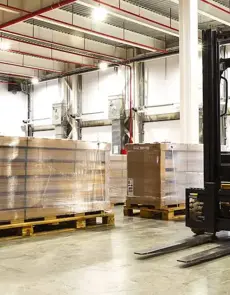Don't settle for less: Choose the highest-rated, most-recommended inventory software on the planet
Every day in Unleashed software...
+
sales orders processed
+
active users
M+
stock items processed
How will Unleashed help your business?
Grow profits, save time, & boost performance by unifying all your buying, warehousing, sales & production processes within a simple, smart, and advanced stock control software.

Simplifies stock management
No more hours of pointless stock counts. Unleashed's digital stock counts take away the guess work every day, making stocktaking a breeze.

Manages multiple stock locations
Say 'no' to endless Excel spreadsheets for your multilocation inventory! You can now easily keep track of your inventory in multiple warehouses without losing sight of your stock.

Automates purchase reorders & supplier management
Manage all your purchasing in one place with fast & easy purchase orders, optimised replenishment levels, demand inventory forecasting, supplier management & more.

Streamlines production management
Master manufacturing with the kanban planner + digital bills of materials that automatically cost your products – so your margins are always accurate.

Refines B2B sales order management
Deliver exceptional B2B buyer journeys within a powerful B2B eCommerce portal that keeps track of stock availability, order status, previous order history, and more.

Perfects demand planning with powerful forecasting and reporting
Manage demand fluctuations smoothly with intuitive inventory forecasting, customised replenishment strategies that save you thousands, and easy inventory reporting.

Improves inventory traceability by batch and serial numbers
Easily track and trace raw materials and finished goods by batch and serial number.

Super-charges multichannel sales tracking and accounting
Action orders from B2B sales portals, eCommerce integrations, and offline sources all in one place. Track your most profitable lines, set KPIs, generate invoices, get accurate weighted average landed costs & more.

Streamlines customer relationship management & improves RFM analysis
Take your sales strategy to the next level with a CRM that connects the dots between the goods you buy and make – and the customers you sell them to.
Power your day with AI
Do more in the moment with Access Evo in Unleashed
- Lift productivity
- Empower staff
- Unlock creativity

Integrate with 30+ applications
Join 1000s of companies from over 100 countries using Unleashed inventory software
What our customers say
Meet our customers
Multi award-winning software
Inventory management software for your industry
Whether you’re B2B, D2C (or a bit of both) Unleashed has the flexibility & features to suit the way you work; from make-to-order manufacturers to wholesale distributors, & everyone in between.
Latest articles
Start your 14-day free trial. No credit card required.
Frequently Asked Questions
What is inventory management software?
What is inventory management software?
Inventory management software is a programme – usually hosted and accessed via the cloud – that creates a digital twin for all the products, parts or ingredients in a business. That online record includes details such as the value, age, location, quantity and dimensions for each product – as well as data on suppliers and customers, including all purchases and sales. With accurate and up-to-date inventory records companies can prevent both over- and under-stocking and see widespread efficiency gains and financial management.
Explore inventory management software in detail in our guide: What is Inventory Management Software?
What does Unleashed software do?
Unleashed is inventory management software that automates and simplifies control across suppliers, production, inventory, and sales. You can use Unleashed to keep track of your inventory and maintain optimal stock levels, manage your purchase orders, plan manufacturing, process sales, and more.
Is Unleashed an ERP system?
Unleashed is not a full ERP system but has numerous features that overlap with ERP functionality. You can also extend Unleashed’s capabilities through API integration with systems like Xero and QuickBooks.
Is Unleashed inventory software free?
You can sign up for a free trial account on Unleashed and use the inventory software free of charge for 14 days. No credit card information is required.
How much does the Unleashed inventory software cost?
You can use Unleashed for 14 days for free without needing your credit card details. Once your trial period is over, you can opt for one of the subscription packages. Find out more on the pricing page.
Is Unleashed tailored for small businesses?
Small and mid-sized businesses worldwide favour Unleashed as their trusted inventory management system. Typical users are companies with between 5 and 500 employees.
Can Unleashed be customised to suit specific business needs?
Unleashed isn’t custom-coded for each user, and can be deployed ‘straight out of the box’. Its flexible workflows, and customisable settings make it suitable for a diverse range of industries.
How do I get my current stock into Unleashed?
Unleashed’s Import/Export Products feature allows you import and manage stock data in bulk. You can import products, stock on hand, serial numbers, product attributes, and more. Find out more in our documentation or contact us and we will gladly help you get started.
Does Unleashed support batch tracking?
Yes, Unleashed gives you total traceability and accuracy in your inventory items through batch tracking. Read more about our batch tracking feature here.
Can I forecast inventory demand in Unleashed?
Yes, you can deploy cost-effective strategies for purchasing, manufacturing and selling items with our inventory forecasting feature.
Can I import and export inventory data?
Yes. You can import products, serial numbers, batch numbers, product attributes, quantity pricing, and more in Unleashed software. You can also export sales orders, customer information, purchase orders, and more. Read more on our support page.
Does Unleashed offer customer support and onboarding?
We offer the best-rated onboarding and customer support service for inventory management in the business, ensuring you get the best out of Unleashed through onboarding, support, and training.
Can I keep track of my inventory in real time?
Yes, Unleashed provides live updates on stock levels, sales, purchase orders, and more through customisable reports.
Can Unleashed automate my inventory management?
Yes, Unleashed comes with extensive automation features for every workflow – from pre-filling Purchase Orders with your preferred supplier details, to synching stock levels with your sales channels and logistics partners, or alerting you to expiring batches.
Is Unleashed inventory software scalable with my business?
Absolutely! Unleashed is an inventory management system that scales as your business grows, with unlimited warehouses, multi-currency support and the ability to work across multiple locations. Pre-built integrations let you connect with other popular cloud software tools, and open API access lets you tailor your tech stack and build EDI connections as required. You can also easily add or remove licenses to ensure everyone on your team has the access they need.
Can I integrate Unleashed with third-party tools?
Yes, Unleashed software supports numerous integrations with tools like BigCommerce, Squarespace, Etsy, Amazon, Shopify, Xero, Quickbooks and many others. Find out more on our integrations page.
Does Unleashed provide an API?
Yes, Unleashed has open API access plus an API sandbox that allows you to connect Unleashed to your other tools in almost any way you like. Find out more in our API documentation.
Does Unleashed integrate with eCommerce platforms like Shopify, WooCommerce and Amazon?
Yes, Unleashed integrates with Shopify, WooCommerce and Amazon via pre-built integrations that are supported and maintained by Unleashed – and can also be easily connected with eCommerce software tools such as Ebay, Etsy, Magento and Squarespace via 3rd party connectors. Connecting your eCommerce stores allows for a fully automated workflow from sale to delivery, replenishment and invoicing, plus synchronised stock availability.
What integrations does Unleashed support for accounting?
You can instantly integrate Unleashed with your preferred accounting platforms such as Xero, QuickBooks, Access Financials, or Pencil – and any other online accounting system using the Unleashed API, which enables synchronisation of your inventory and financial data.
What kind of reporting and analytics does Unleashed inventory software offer?
Unleashed keeps track of all inventory movements with comprehensive and detailed reporting, including an optional Business Intelligence module that allows you to segment your inventory data, set business KPIs, personalise your reports, and turn actionable insights into informed decisions.










































